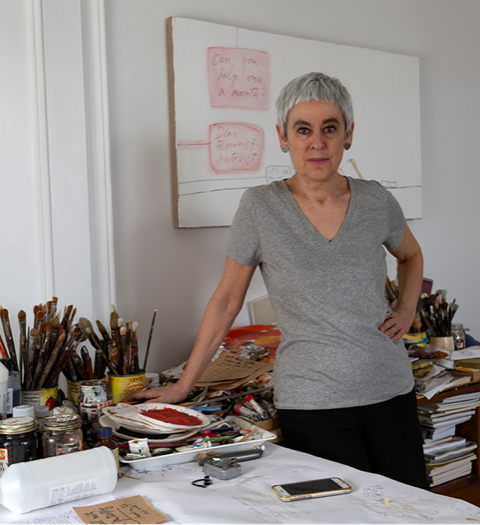Visiting Professor Mira Schor: A woman artist is always too young or not dead enough
Mira Schor is a seasoned visual artist, critic and feminist. Based in New York, Schor visited the Academy of Fine Arts through the Visiting Professor programme autumn 2019. According to Schor, the world continues to be different for women and men working as artists.

Mira Schor shares an anecdote of Carmen Herrera, an American artist.
“Herrera was not very well known as an artist when she was offered the opportunity to organise an exhibition at the Whitney Museum a couple of years ago. At the time, Herrera was 99 years old. She was given the following choice: she could either wait for one year and get a smaller exhibition, or she could wait for two years and get a larger one. Well, she chose to have a smaller exhibition, and she actually lived to see it happen.”
Mira Schor, 69, is a New York based visual artist, feminist, critic and teacher. Schor, who is coming to Helsinki to teach and give lectures through the Visiting Professor programme of the Academy of Fine Arts, is well known for her feminist paintings, textual art, drawings and books. Her publications include, for example, A Decade of Negative Thinking: Essays on Art, Politics, and Daily Life published in 2010.
The anecdote about Carmen Herrera is revealing of the woman’s position in the world of painting in the United States. Schor continues on the same theme by sharing a description of the three ages of a woman artist, which she heard a couple of years ago: “Young and naked – still too young – not dead enough. I think that personally I’m somewhere between the last two stages – still too young but not quite dead enough,” Schor says with a laugh.
On a more serious note, Schor is a much sought-after artist and speaker, who has recently worked both in the United States and in Europe. Before coming to Helsinki, Schor will give a talk at the FIAC Contemporary Art Fair in Paris, where her works are also exhibited. Next year, exhibitions showcasing her work will be organised in Zurich and Berlin, for example.
Feminist from a young age
Mira Schor was born into a family of artists who had immigrated to the United States from Poland via Paris in 1950. When asked about how she became a feminist, Schor takes us back to her childhood.
“I was a smart and artistic girl. But I could feel that this was not something which women were appreciated for. Women were primarily expected to get married and become a mother. I didn’t know a single woman who was focusing on making a career.”
Mira’s mother Resia Schor was an artist, but she stayed at home. The career of Ilya Schor, Mira’s father who was also an artist, was given priority.
When Mira Schor was eleven, her father passed away.
“I got to see how badly society treated a woman who was no longer protected by her role as the wife of a well-respected man. But my mother persevered by taking her own art in new directions. She never remarried, preferring to stay independent instead.”
When Schor was a teenager, her older sister, feminist theoretician and researcher Naomi Schor was part of the feminist movement that was going through the exciting years of the second wave. It was not long before Mira also got involved in the movement.
In 1971, Schor began her studies at the Californian Institute of the Arts.
“There was a feminist programme starting at CalArts directed by Judy Chicago and Miriam Schapiro. You had to choose whether you wanted to be in or out. I chose to be in. That’s how I officially became a feminist.”
A woman’s value is connected to her age
When Schor was young, she used to wander around the art museums in New York, searching for works by woman artists. However, there was little to be found.
“There were people like Helen Frankenthaler and Georgia O’Keeffe, but that was really all there was. There were maybe two or three successful woman artists at the time.”
Nowadays the situation is different. All exhibitions include works by female artists, and women can make a career in art just like men. Nevertheless, Schor thinks that the world is still very different for male and female artists.
One problem that particularly affects young female students is sexual harassment, which all too often continues to be unpunished. Another challenge that female artists need to face relates to their career after they have enjoyed the first wave of success.
“You may graduate, have exhibitions, gain success and fame and sell a lot of works. But when you’re 35 or 40, people suddenly lose interest in you.”
The value of a woman artist is still connected to her age and appearance, to the ways in which she can be used, Schor says.
Typically, the next opportunity to have a career in art only arrives “on the verge of death”, when the woman artist can be rediscovered, so to speak.
“It’s really unfair that you can’t advance your career when you’re in your forties, physically strong, and in touch with the world in various ways,” Schor says.
However, Schor herself seems to be extremely energetic, strong and in touch with the world. Her lectures in Helsinki focus on her background and her art, but also on the feminist theoreticians who have influenced her way of thinking, criticism of postmodern painting, and topics like the relevance of Instagram to texts about art.
Text: Silja Ylitalo